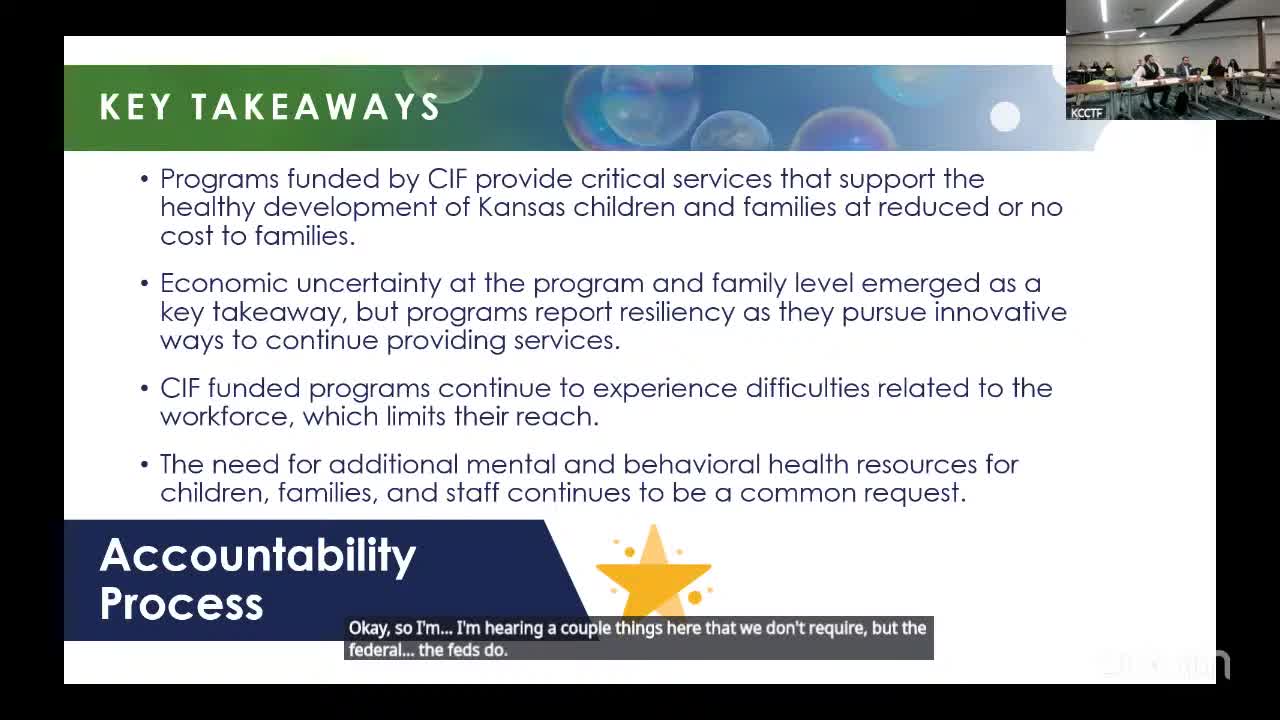Kansas Budget Discussion Highlights Challenges in Childcare Funding and Accessibility
June 07, 2025 | Children’s Cabinet, Governor's Boards & Commissions, Organizations, Executive, Kansas
This article was created by AI summarizing key points discussed. AI makes mistakes, so for full details and context, please refer to the video of the full meeting. Please report any errors so we can fix them. Report an error »

In a recent meeting of the Kansas Children's Cabinet & Trust Fund Board, discussions centered around the allocation and utilization of funding for child care programs, revealing both opportunities and challenges in the system. As board members gathered, the atmosphere was charged with a sense of urgency to address the needs of children and families across the state.
One of the key topics was the funding structure, particularly the $5,033,000 from the Child Improvement Fund (CIF), which is primarily sourced from tobacco revenue. Board members expressed concerns about the limitations imposed on these funds, particularly regarding their distribution and use by the Department for Children and Families (DCF). A member highlighted the need for more flexibility in how these funds are utilized, advocating for a system that prioritizes home-based care environments over larger, licensed facilities. "Philosophically, I think a child is best in a home environment," they stated, emphasizing the potential benefits of allowing parents to choose care options that suit their families best.
The conversation also touched on the unique structure of Kansas's subsidy payments, which are directed to parents rather than providers. This system allows parents to select their preferred childcare arrangements, but it does come with restrictions. For instance, care provided by relatives or unlicensed caregivers is not eligible for funding, which some board members argued could limit options for families and lead to higher costs.
In addition to funding discussions, the board examined the "Parents as Teachers" program, which aims to support early childhood education. Out of 286 school districts in Kansas, only 153 utilize this program, raising questions about accessibility and outreach. The lack of a means test for the program was also noted, allowing families of all income levels to participate, but some members suggested that this could be improved to better serve those in need.
As the meeting concluded, it was clear that while there are significant resources available for child care and education, the board faces ongoing challenges in ensuring these funds are used effectively and equitably. The discussions underscored a commitment to exploring innovative solutions that prioritize the well-being of Kansas's children and families, setting the stage for future initiatives aimed at enhancing the state's child care landscape.
One of the key topics was the funding structure, particularly the $5,033,000 from the Child Improvement Fund (CIF), which is primarily sourced from tobacco revenue. Board members expressed concerns about the limitations imposed on these funds, particularly regarding their distribution and use by the Department for Children and Families (DCF). A member highlighted the need for more flexibility in how these funds are utilized, advocating for a system that prioritizes home-based care environments over larger, licensed facilities. "Philosophically, I think a child is best in a home environment," they stated, emphasizing the potential benefits of allowing parents to choose care options that suit their families best.
The conversation also touched on the unique structure of Kansas's subsidy payments, which are directed to parents rather than providers. This system allows parents to select their preferred childcare arrangements, but it does come with restrictions. For instance, care provided by relatives or unlicensed caregivers is not eligible for funding, which some board members argued could limit options for families and lead to higher costs.
In addition to funding discussions, the board examined the "Parents as Teachers" program, which aims to support early childhood education. Out of 286 school districts in Kansas, only 153 utilize this program, raising questions about accessibility and outreach. The lack of a means test for the program was also noted, allowing families of all income levels to participate, but some members suggested that this could be improved to better serve those in need.
As the meeting concluded, it was clear that while there are significant resources available for child care and education, the board faces ongoing challenges in ensuring these funds are used effectively and equitably. The discussions underscored a commitment to exploring innovative solutions that prioritize the well-being of Kansas's children and families, setting the stage for future initiatives aimed at enhancing the state's child care landscape.
View full meeting
This article is based on a recent meeting—watch the full video and explore the complete transcript for deeper insights into the discussion.
View full meeting
